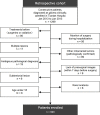Spatial distribution of supratentorial diffuse gliomas: A retrospective study of 990 cases
- PMID: 36761940
- PMCID: PMC9904506
- DOI: 10.3389/fonc.2023.1098328
Spatial distribution of supratentorial diffuse gliomas: A retrospective study of 990 cases
Abstract
Background: Gliomas distribute unevenly in the supratentorial brain space. Many factors were linked to tumor locations. This study aims to describe a more detailed distributing pattern of these tumors with age and pathological factors concerned.
Methods: A consecutive series of 990 adult patients with newly-diagnosed supratentorial diffuse gliomas who underwent resection in Beijing Tiantan Hospital between January 2013 and January 2017 were retrospectively reviewed. For each patient, the anatomic locations were identified by the preoperative MRI, and the pathological subtypes were reviewed for histological grade and molecular status (if any) from his medical record. The MNI template was manually segmented to measure each anatomic location's volume, and its invaded ratio was then adjusted by the volume to calculate the frequency density. Factors of age and pathological subtypes were also compared among locations.
Results: The insulae, hippocampi, and corpus callosum were locations of the densest frequencies. The frequency density decreased from the anterior to posterior (frontal - motor region - sensory region - parietal - occipital), while the grade (p < 0.0001) and the proportion of IDH-wt (p < 0.0001) increased. More tumors invading the right basal ganglion were MGMT-mt (p = 0.0007), and more of those invading the left frontal were TERT-wt (p = 0.0256). Age varied among locations and pathological subtypes.
Conclusions: This study demonstrated more detailed spatial disproportions of supratentorial gliomas. There are potential interactions among age, pathological subtypes, and tumor locations.
Keywords: WHO grade; age; diffuse gliomas; molecular status; spatial disproportion; supratentorial.
Copyright © 2023 Li, Yin, Zhang, Xue, Yang, Li, Pan, Hou, Hao, Yu, Ji, Gao, Deng and Xie.
Conflict of interest statement
The authors declare that the research was conducted in the absence of any commercial or financial relationships that could be construed as a potential conflict of interest.
Figures



Similar articles
-
Perfusion and diffusion MRI signatures in histologic and genetic subtypes of WHO grade II-III diffuse gliomas.J Neurooncol. 2017 Aug;134(1):177-188. doi: 10.1007/s11060-017-2506-9. Epub 2017 May 25. J Neurooncol. 2017. PMID: 28547590 Free PMC article.
-
Is it appropriate to redefine the indication for stereotactic brain biopsy in the MRI Era? Correlation with final histological diagnosis in supratentorial gliomas.Minim Invasive Neurosurg. 2008 Apr;51(2):109-13. doi: 10.1055/s-2008-1058096. Minim Invasive Neurosurg. 2008. PMID: 18401825
-
Neuro-radiological characteristics of adult diffuse grade II and III insular gliomas classified according to WHO 2016.J Neurooncol. 2019 May;142(3):511-520. doi: 10.1007/s11060-019-03122-1. Epub 2019 Feb 11. J Neurooncol. 2019. PMID: 30756272
-
IDH mutations in older patients with diffuse astrocytic gliomas.Ann Diagn Pathol. 2020 Dec;49:151653. doi: 10.1016/j.anndiagpath.2020.151653. Epub 2020 Oct 25. Ann Diagn Pathol. 2020. PMID: 33137656 Review.
-
Clinical impact of revisions to the WHO classification of diffuse gliomas and associated future problems.Int J Clin Oncol. 2020 Jun;25(6):1004-1009. doi: 10.1007/s10147-020-01628-7. Epub 2020 Feb 4. Int J Clin Oncol. 2020. PMID: 32020379 Review.
References
LinkOut - more resources
Full Text Sources
Research Materials

